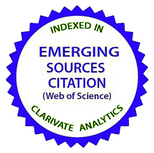Діаграма фазових рівноваг системи Y–Dy–Ge при 870 K
DOI:
https://doi.org/10.15330/pcss.26.1.166-173Ключові слова:
інтерметаліди, потрійна система, фазові рівноваги, твердий розчин, фізичні властивостіАнотація
Взаємодія компонентів у потрійній системі Y–Dy–Ge досліджена в повному концентраційному інтервалі за температури 870 K методами рентгенівського і мікроструктурного аналізів, енергодисперсійної рентгенівської спектроскопії. Між ізоструктурними бінарними германідами ітрію та диспрозію утворюються неперервні тверді розчини заміщення Y1-xDyxGe1,5 (структурний тип AlB2),
Y3-xDyxGe5 (структурний тип Y3Ge5), Y1-xDyxGe (структурний тип CrB), Y11-xDyxGe10 (структурний тип Ho11Ge10), Y5-xDyxGe4 (структурний тип Sm5Ge4) та Y5-xDyxGe3 (структурний тип Mn5Ge3). Сполуки YGe1,82 (структурний тип YGe1,82) та YGe2 (структурний тип α-ThSi2) розчиняють 0,20 та ~ 0,10 ат. частки Dy відповідно, DyGe1,9 (структурний тип TbGe2) ~ 0,07 ат. частки Y, DyGe1,85 (структурний тип DyGe1,85) – 0,05 ат. частки Y.
Досліджено електричні та магнітні властивості сплавів складу Y5Dy30Ge65 (структурний тип DyGe1,85) та Y30Dy5Ge65 (структурний тип YGe1,82). Зразок складу Y30Dy5Ge65 є парамагнетиком Кюрі-Вейса. На термограмі при охолодженні сплаву Y10Dy20Ge65 спостерігаємо інтенсивний пік за температури 1207,4 K (у максимумі), термічний ефект якого відображає утворення фази Y1-xDyxGe1,85.
Посилання
O. I. Bodak, Z. M. Shpyrka, I. R. Mokra, Peculiarities of the interaction of the components in the systems of two rare earth metals and germanium, J. Alloys Comp., 247, 217 (1997); https://doi.org/10.1016/S0925-8388(96)02589-3.
Z. Shpyrka, K. Kluziak, B. Rożdżyńska-Kiełbik, A. Stetskiv, V. Pavlyuk, The isothermal section of the phase diagram of Sm–Dy–Ge ternary system at 873 K, J. Phase Equilib. Diff., 39(6), 750(2018); https://doi.org/10.1007/s11669-018-0665-9.
Т. Melnyk, Z. Shpyrka, The investigation of the solid Gd–Tm–Ge system at 870 K, Visnyk Lviv Univ. Ser. Chem., 52, 3 (2011).
N. Guk, Z. Shpyrka, P. Starodub, The investigation of the Er–Tm–Ge system in the 0,5–1,0 at. part. of Ge region,Visnyk Lviv Univ. Ser. Chem., 50, 18 (2009).
Z. Shpyrka, L. Drab, The investigation of the solid solutions DyGe2–RGe2, R – Y, Gd, Tb, Ho, Er, Tm and Lu at 600 oС, Visnyk Lviv Univ. Ser. Chem., 49, 98 (2008).
Z. Shpyrka, Yu. Cheh, O. Yuziv, N. German, V. Pavlyuk, X-ray investigation of alloys on the cross sections RGe2–LuGe2 (R – Pr, Nd) and SmGe2–R′Ge2 (R′ – Gd, Tb, Ho, Er, Tm), Visnyk Lviv Univ. Ser. Chem., 60, 64 (2019); http://dx.doi.org/10.30970/vch.6001.064.
Z. Shpyrka, N. German, Phase equlibria in the quasibinary sections GdGe2–RGe2 (R = Ho, Lu), Coll. Abst. XVIII Int. Sem. Phys. and Chem. of Solids, 54 (2012).
Z. Shpyrka, N. German, V Pavlyuk, The investigation of the GdGe2–LuGe2 system at 870 K, Visnyk Lviv Univ, Ser. Khim., 55(1), 37 (2014).
V. Vorotnyak, Z. Shpyrka, N. German, The quasibinary sections GdGe2–HoGe2 at 870 K, Visnyk Lviv Univ. Ser. Chem., 54, 45 (2013).
O. Kravchuk, Z.Shpyrka, N. German, V. Pavlyuk, The investigation of the quazibinary cross section SmGe2–LuGe2, Visnyk Lviv Univ. Ser. Chem., 59, 83 (2018); https://doi.org/10.30970/vch.5901.083.
W. Kraus, G. Nolze, POWDER CELL – a program for the representation and manipulation of crystal structures and calculation of the resulting X-ray powder patterns, J. Appl. Crystallogr., 29, 301 (1996); https://doi.org/10.1107/S0021889895014920.
L. Akselrud, Yu. Grin, WinCSD: Soft ware package for crystallographical calculations (Version 4), J. Appl. Crystallogr., 47, 803 (2014); https://doi.org/10.1107/S1600576714001058.
T. B. Massalski, Binary Alloy Phase Diagrams, ASM, MetalsPark, Ohio(1990).
H. Okamoto, Desk Handbook: Phase Diagrams for Binary Alloys, Materials Park (OH): ASM (2000).
O. Schob, E. Parthe, Digermanide des Scandium and Yttrium, Monatsheftefuerchemie, 95, 1466 (1964).
V. A. Bruskov, O. I. Bodak, E. I. Gladyshevskii, The Crystal Structure of Y3Ge5 (YGe1,7), J. Phys. Cryst., 28(2), 151 (1983).
A. K. Ghosh, D. H. Douglass, Superconductity in non-cubic crystal structures, Solid St. Commun., 23, 223 (1997); https://doi.org/10.1016/0038-1098(77)90447-1.
O. Zaharko, P. Schobinger Papamantellos, C. Ritter, Antiferromagnetic ordering in the novel Ho3Ge5 and HoGe1,85 compounds studied by X-ray and neutron diffraction, J. Alloys Comp., 280, 4 (1998); https://doi.org/10.1016/S0925-8388(98)00555-6.
O. Oleksyn, P. Schobinger Papamantellos, C. Ritter, C. H. de Groot, K. H. J. Buschow,Structure and magnetic ordering in the defect compound ErGe1,83, J. Alloys Comp., 252, 53 (1997).
Z. S. Staskevych, A. M. Goryn, Z. M. Shpyrka, The investigation of the physical properties of alloys of the ternary Y–Dy–Ge system, Coll. Abst. X Ukr. Sci. conf. Students and graduate students “Chemical Karazinreadings – 2018”. 53 (2018).
##submission.downloads##
Опубліковано
Як цитувати
Номер
Розділ
Ліцензія
Авторське право (c) 2025 Z. Shpyrka , Z. Staskevych, A. Horyn, V. Pavlyuk

Ця робота ліцензованаІз Зазначенням Авторства 3.0 Міжнародна.










